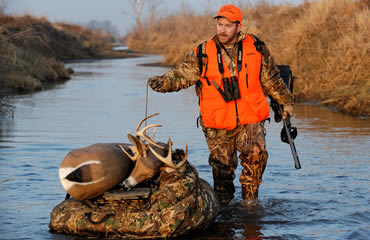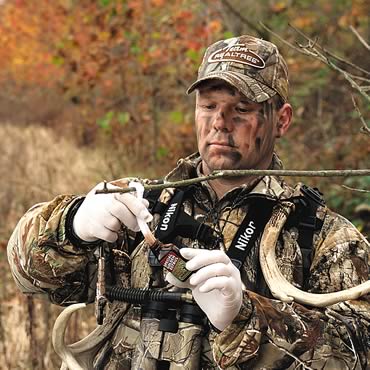Small isolated cover areas can produce big results.
I am not sure who coined the phrase “bigger is always better,” but it certainly applies to whitetail hunters. We’re always trying to shoot the biggest buck. What many hunters overlook is the fact that the biggest buck does not necessarily come from the largest tract of huntable land.
When you are looking for a new public land place to hunt and you have some options, aren’t you first drawn to the one with the most huntable acreage? Even those who have the luxury of hunting or leasing private ground often rate its worth by how much real estate is included.
I used to be that way. Today, I’ll take quality over quantity. That might mean hunting anything from a small patch of woods along a major interstate to a nearly impenetrable thicket on a farm that is mostly tilled land.
I have many examples, but the bottom line on hunting small pockets is they are rarely, if ever, hunted by anyone else.
For example, I have permission to hunt some land along the Cimarron River drainage in southwest Kansas. One side is bordered by 3,000 acres of city-owned land designated as a wildlife sanctuary.
The bottom on my friend Jeff Louderback’s ranch is filled with old cottonwoods, while the adjacent hillsides are nothing more than sand hills covered with sagebrush. In the bottom is a little bump that juts up against the boundary fence, creating a thumb-like protrusion that offers deer added cover as they slip out of the thick bedding cover of the preserve and into the cottonwoods, which they use to travel the half-mile to a neighboring farm where corn is grown.
This tiny pocket measures no more than 100 yards by 100 yards, yet every year I see at least one absolute whopper buck cruising through there.
The big reason? During gun season, hunters work both sides of the bottom in the sagebrush, but they cannot access this little sanctuary pocket. Because I hunt it sparingly and during the second bow season, it remains a safe haven for mature bucks. Or, so they think.
Last fall in Illinois, I shared camp for a few days with Wayne Prajean, one of the best treestand designers and big buck hunters I know.
It was in late October, and Wayne had hunted a spot he has permission to access in Kansas during the early archery season. His setup was nothing more than a relatively short line of trees that bisect the prairie and feed into some cornfields. Wayne used trail cameras to help him locate and pattern the buck he wanted. He arrowed him on camera opening day. Gross score was 171 inches.
When it comes to cover, size doesn’t always matter.
 WHY HUNT SMALL POCKETS?
WHY HUNT SMALL POCKETS?
Whitetails live in tiny patches of cover for a variety of reasons. Sometimes it’s simply the best they can do. On Western and Midwestern prairies, a thin line of windrow trees along a drainage, or a tiny clump of dwarf elms or big cedars near an abandoned homestead might be the closest thing a buck has to classic whitetail habitat.
Those of you who hunt on farms east of the Mississippi or in the South would be shocked to see the amount of buck sign in these little wooded areas.
The more you scout, the more you’ll find that even when they have vast expanses of hardwoods and brush available, whitetails often live in a much smaller area. Usually it’s a matter of convenience, particularly if they can find food, water and lots of peace and quiet in one small area. The same is true in agricultural areas, where small patches of trees surrounded by crops are often where mature deer live. If left alone, they feel secure, and they need to walk only a few yards to feed on crops at night.
THE BEST TIME
Even if whitetails do not live in them year-round, small pockets of cover are worth checking once hunting season opens. If a cover patch is big enough to hide a large dog, it is big enough to hide a pressured whitetail. The more little pockets are located out in the open, the more attractive they are to whitetails. They’re seldom checked by hunters, and they offer a wide-open view of approaching danger.
My friend Jeff Louderback and I were cruising his ranch one below-zero morning during gun season in Kansas last December. We looked out across the wide-open sagebrush and spotted three does standing still in soft light just before sunup. As their breath escaped in little puffs I looked 75 yards to their right, and there stood a very nice 10-pointer.
All the deer started walking slowly before the buck bedded down behind a small brushy hump about the size of a living room. Jeff decided he wanted the buck, so he grabbed his rifle and walked over, expecting to kick the buck up at close range and be able to shoot it before it made it to the trees a quarter mile distant.
After 20 minutes of trying to get the buck up to no avail, we decided he must have slipped into the trees with the does. It wasn’t until late that afternoon as we drove past that we saw the buck stand up in the very same place. He’d been there all along. Jeff’s 7mm Rem Mag made sure he didn’t fool us again.
 SUCCESSFULLY PICKING POCKETS
SUCCESSFULLY PICKING POCKETS
Successfully picking pocket whitetails is different from hunting bucks in more traditional terrain.
Pocket whitetails have no patience for human intrusion. While they often hold tight until the last possible second, if you bump them out of their cover, they often don’t return for months, if at all. The smaller the area, the smaller your chance of ever getting another opportunity.
In open country, I like to do in-season scouting from long distance with good optics early and late in the day.
If the pocket is fairly large — up to five acres or so — it is possible to cautiously walk up to the edge and check for sign.
I look for perfect wind conditions and the ability to get to and from the place without being seen or heard. I try to stay on the perimeter, resisting the urge to follow rub lines or tracked-up trails. Remember that the smaller a buck’s bedding area, the larger its paranoia.
Ready to hunt the pocket? You’ll need as much planning and stealth as when scouting. When gun hunting, I use netting and make a small natural blind up against a tree trunk. When bowhunting, I pick a tree that requires little or no trimming. I also try to set up a treestand on a day when wind will help mask noise.
IF THEY WON’T MOVE
What if the bucks in the little pocket patch won’t show themselves?
During gun season, some deer hunters turn to organized drives. However, I’ve seen very few deer drives that were even close to being organized. Before you drive and ruin a patch of cover for the rest of the season, be creative.
I remember locating a plum thicket about the size of my high school gym. It was inside a patch of tall cottonwoods and thick cedars, and the perimeter was loaded with fresh scrapes. There were several trails leading into the thicket, but one seemed a bit larger and more beaten down than the others. I put a treestand 50 yards from the tunnel-like opening and hunted it three afternoons.
The first two days, I heard deer walking around inside the thicket and even heard a buck grunt a time or two. On evening three, with about 30 minutes of shooting light left, I changed my style and grunted softly, following with a couple of soft doe bleats. Just before the end of light, a buck came out, nose in the air. I introduced him to my broadhead. I’ve had similar luck using sex attractant scents during the rut.
The key to successfully hunting that pocket was being able to get in without being detected.
I’d noticed the area on an aerial photograph and thought it might be worth checking. A small stream ran from a spot where the trees met an agricultural field, and the stream covered my scent and masked the noise of my approach.
Once I got close, I stopped walking and spent a lot of time looking through my binoculars. It is amazing how much detail you can see with good glass — rubs on tree trunks, whether scrapes have been freshened, trails that have been recently used, even if there are acorns, apples or persimmons available.
I kept asking myself the same question I always ask when stalking a bedded mule deer buck: “Why am I in such a hurry to screw this up?”
I took my time and returned the next day with everything I needed to quickly and quietly set up my stand.
SECRET POCKETS
You can find little pockets just about everywhere if you use your imagination. Some of the biggest bucks shot these days are taken right in or next to towns and cities. More municipalities have turned to deer hunting to help control burgeoning populations. I’ve sat in some suburban treestands where I was actually able to watch TV with my binos through a patio sliding glass door as deer walked right under me.
In Wisconsin one year, an outfitter pulled me aside and asked if I would be willing to do some walking, as he had a little pocket he thought would be excellent.
I said yes and was amazed at how short the walk was. It led to the top of a hill crowned with hardwoods and surrounded by fields of standing corn. The deer were bedding in the brush up on top, and my stand was on the edge. I saw numerous bucks chasing does out of range before a bruiser 8-pointer gave me a 10-yard shot. The secret was isolation and no human encroachment.
The key is to think outside the box. Once you locate a small, isolated cover thicket where deer can live or sleep without being bothered by people, become a stealth hunter.
It’s a chess game, not a rugby scrum. The smart, patient and diligent will prevail, not the strong and bullheaded.
Read Recent Articles:
• A Perfect Match: There’s an accurate load for YOUR slug shooter.
• Two Shots, One Record: The Story of Kentucky’s top crossbow buck.
• The Next Level: Stand efficiency makes the difference between a close encounter and a filled tag.
This article was published in the October 2011 edition of Buckmasters Whitetail Magazine. Subscribe today to have Buckmasters delivered to your home.